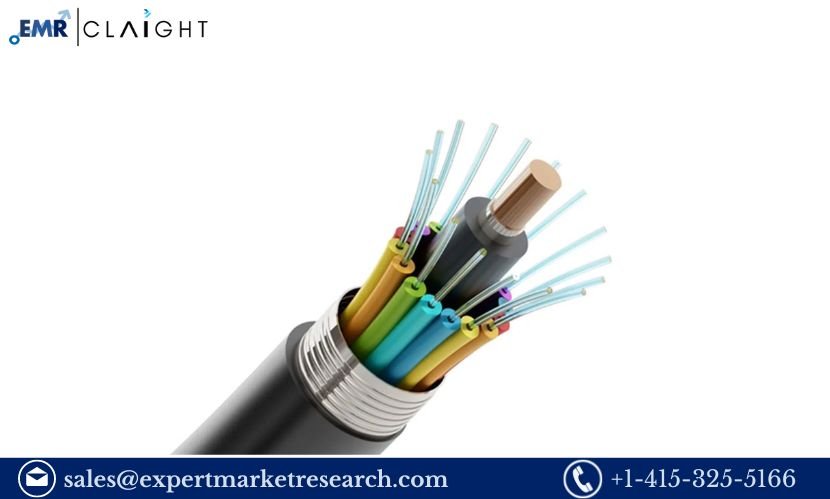Table of Contents
ToggleIntroduction
Fiber optic cables are revolutionizing telecommunications and data transmission by providing faster, more reliable connections than traditional copper cables. As the demand for high-speed internet, cloud computing, and data centers continues to surge, establishing a fiber optic cable manufacturing plant presents a significant business opportunity. This Fiber Optic Cable Manufacturing Plant Project Report explores the essential components involved in setting up a fiber optic cable manufacturing facility, including market analysis, production processes, financial considerations, and environmental impacts.
Market Analysis
Demand Overview
The fiber optic cable market has been experiencing robust growth due to several driving factors:
- Rising Internet Traffic: The proliferation of online content and streaming services has led to an exponential increase in internet traffic, necessitating more efficient data transmission solutions.
- Expanding Telecommunications Infrastructure: Many countries are investing heavily in upgrading their telecommunications infrastructure to support 5G networks, further increasing the demand for fiber optic cables.
- Growth in Data Centers: As businesses increasingly rely on cloud computing and big data analytics, the number of data centers is rising, driving demand for high-capacity fiber optic solutions.
Market Trends
Key trends shaping the fiber optic cable industry include:
- Technological Advancements: Innovations in manufacturing techniques and materials are leading to stronger and more flexible fiber optic cables.
- Increased Adoption of Fiber-to-the-Home (FTTH): Many service providers are expanding their fiber networks to residential areas, enhancing access to high-speed internet.
- Sustainability Focus: With growing environmental awareness, manufacturers are increasingly adopting eco-friendly practices in production and waste management.
Get a Free Sample Report with Table of Contents @
Growth Potential
The global fiber optic cable market is projected to grow at a CAGR of approximately 10-12% over the next five years. Regions such as North America and Asia-Pacific are expected to drive significant growth, fueled by investments in telecommunications and internet infrastructure.
Technical Feasibility
Types of Fiber Optic Cables
Fiber optic cables can be categorized into two main types:
- Single-Mode Fiber (SMF): Designed for long-distance communication, single-mode fibers have a smaller core diameter and allow only one mode of light to propagate.
- Multi-Mode Fiber (MMF): Suitable for shorter distances, multi-mode fibers have a larger core diameter and can carry multiple light modes, making them ideal for data centers and local area networks.
Production Process
The manufacturing process of fiber optic cables involves several critical stages:
Preform Fabrication: The process begins with creating a glass preform, which is a cylindrical piece of glass that will be drawn into fiber. The preform is made using the Modified Chemical Vapor Deposition (MCVD) method, which ensures high purity and specific refractive index profiles.
Drawing the Fiber: The preform is heated in a drawing tower, where it is melted and drawn into thin strands of fiber. This process requires precise control of temperature and speed to achieve the desired diameter (typically 125 micrometers for standard fiber).
Coating: The drawn fiber is coated with a protective layer, usually a polymer, which provides strength and flexibility. This coating also protects the fiber from environmental factors.
Cabling: Multiple fibers are bundled together and encased in an outer protective jacket. This process may include adding strength members and additional layers for moisture resistance.
Testing and Quality Control: Rigorous testing is conducted to ensure that the cables meet industry standards. Tests include checking for optical performance, mechanical strength, and environmental resistance.
Plant Layout and Design
An efficient fiber optic cable manufacturing plant should include:
- Raw Material Storage: For storing silica and other materials used in the production process.
- Preform Fabrication Area: Equipped for producing glass preforms using MCVD technology.
- Fiber Drawing Area: For drawing and coating fiber optic cables.
- Cabling Area: For assembling and packaging finished products.
- Quality Control Lab: For conducting tests on fibers and finished cables.
- Waste Management Area: To handle by-products and ensure compliance with environmental regulations.
Required Equipment
Key equipment needed for a fiber optic cable manufacturing plant includes:
- MCVD Equipment: For creating glass preforms.
- Fiber Drawing Towers: For drawing fibers from the preforms.
- Coating Machines: For applying protective coatings.
- Cabling Machines: For bundling and packaging fiber optic cables.
- Testing Equipment: Such as Optical Time Domain Reflectometers (OTDR) for performance testing.
Financial Analysis
Capital Investment
The capital investment required for setting up a fiber optic cable manufacturing plant can vary significantly based on factors such as location, scale, and technology used. On average, initial investment costs range from $5 million to $20 million.
Breakdown of Costs:
- Land and Building: 30%
- Machinery and Equipment: 50%
- Working Capital: 15%
- Miscellaneous Costs: 5%
Operating Costs
Operational expenses include raw materials (silica, polymers), labor, utilities, maintenance, and administrative costs. The prices of raw materials can fluctuate based on market demand.
Profitability and ROI
With effective production management and strategic marketing, a fiber optic cable manufacturing plant can achieve a return on investment (ROI) of 15-30% within the first three years. Pricing strategies should consider production costs, market demand, and competition.
Environmental Considerations
Establishing a fiber optic cable manufacturing plant necessitates compliance with environmental regulations to minimize ecological impacts. Key considerations include:
- Sustainable Practices: Implementing practices to minimize waste and energy consumption during production.
- Waste Management: Developing systems for recycling and managing by-products, particularly glass and plastic waste.
- Emission Control: Utilizing technologies to minimize emissions during manufacturing processes.
FAQ
What are fiber optic cables used for?
Fiber optic cables are primarily used for telecommunications, internet data transmission, and connecting data centers due to their high bandwidth and long-distance capabilities.
How are fiber optic cables manufactured?
The manufacturing process involves creating glass preforms, drawing them into fibers, applying protective coatings, and then bundling and packaging them into cables.
What are the main types of fiber optic cables?
The two main types of fiber optic cables are single-mode fiber (SMF) for long distances and multi-mode fiber (MMF) for shorter distances, commonly used in data centers.
How long does it take to set up a fiber optic cable manufacturing plant?
Setting up a manufacturing plant can take between 1 to 3 years, depending on regulatory approvals, construction timelines, and equipment procurement.
What are the environmental impacts of a fiber optic cable manufacturing plant?
Potential environmental impacts include waste generation and emissions. Compliance with regulations and effective waste management practices are crucial for mitigating these impacts.
What is the expected return on investment for a fiber optic cable plant?
A well-managed fiber optic cable manufacturing plant can expect an ROI of 15-30% within the first three years of operation.
Company Name: Claight Corporation
Contact Person: Lewis Fernandas, Corporate Sales Specialist — U.S.A.
Email: sales@expertmarketresearch.com
Toll Free Number: +1–415–325–5166 | +44–702–402–5790
Address: 30 North Gould Street, Sheridan, WY 82801, USA
Website: www.expertmarketresearch.com
Aus Site: https://www.expertmarketresearch.com.au




